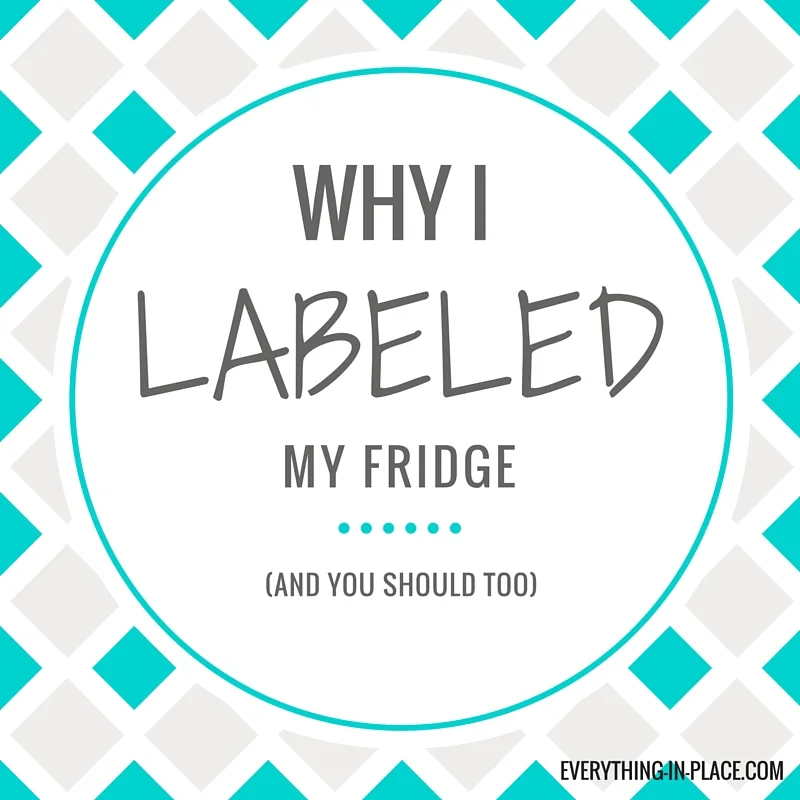As seen on Huffington Post
Professional Organizers and Labels go together like Peanut Butter and Jelly (or nut-free soy butter and jelly, depending on your allergies). So, it is shocking to me that it took me this long to put labels inside my refrigerator.
For 6 weeks after I had my third child I didn’t work. By this I really mean that I worked exclusively from home and didn’t do any on-site client visits. This meant that I spent WAY more time in my house than I normally did. After the haze of newborn sleep deprivation started to wear off I began to notice things again. All of the sudden the consequences of the exhaustion of 3rd trimester followed by the demands of a newborn caught up with me. The “maintenance” step of my organized home had fallen through the cracks and I started to walk through the house and every closet I opened or room I went into was making me crazy. I actually said those words so often that it became a running joke between my husband and I. I would walk into a room and say “Oh my gawd Ben” and he would always reply with “let me guess, the room is making you crazy?!?!?!”. I became fixated on the fridge though. As a nursing mom to a ravenous newborn I am constantly hungry, so I spent many frustrating hours searching through the fridge looking for food. One day I just couldn't take it anymore and I pulled EVERYTHING out.
There are few things more satisfying to me than emptying a space thoroughly cleaning it out and putting everything back in an organized way. It was almost better than a nap. Almost.
Empty & Organize
Since organizing items into zones had been working so well in the pantry I decided to implement the same strategy in the fridge. These zones will be different for everyone depending on the types of foods found in your fridge. To help determine your zones group like items together as you empty the fridge. Keep all the salad dressings together, the sauces, the leftovers, etc. We tend to have five or six types of mustards open at any moment so that is a zone that needed a designated space in our fridge. Maybe you have a hot sauce obsession. Whatever it is, make the system work for you.
Trash It
Now that you have everything organized into groups check all you expiry dates. Now obviously food doesn't immediately turn bad the day after it “expires” but if we are six months past the date on that BBQ sauce and you don’t even remember buying it, let alone opening it, it may be time to say goodbye. Anything moldy or stinky has got to go too, so open those leftovers and be ruthless.
Clean It
Now that you have emptied the entire fridge take a few minutes and give it a serious wipe-down. Don’t forget the shelves on the door and the fruit and veggie drawers. Might as well take advantage of the empty fridge and give it a good clean.
Assess
Take a look at the size and height of your food containers, bottles and jars. The fridge is empty so it’s a great time to move around the glass shelves to accommodate all you food. Try to envision where everything will go and keep the most used food items in front. If you’re not sure if something fits try it out. Adjust the shelf if needed. Move things around if it’s not working. Try a Lazy Susan or clear fridge bins to help you organize it and make it accessible. It’s your fridge, make it work for your needs.
Put It Back
Normally I would have you label things at this step, but that may take a few minutes and since it’s your fridge we’re talking about and your items are perishable that doesn't really make sense. So put all the food back before it spoils . Try to use temporary labels like post-its with tape to keep your fridge in order until you have more permanent labels.
Label It
I know it’s a bit weird to have labels in your fridge, but without proper direction you won’t know where to put things back or find them after. What has really worked for us is to label some zones, but not all. For the most part the food is grouped together by category but there are some items that are just going to have to hang out together because they are all tall or bulky. So instead of doing a “miscellaneous” label (ie an organizer's nightmare) I left it blank and crossed my fingers that common sense will prevail.
*** For the labels I used the FreeStyle Script font in MS Word, printed it out on Full Sheet Clear Decals from Avery and then covered the labels with clear Con-Tact shelf liner to make it washable.***
Maintain It
They key to any organizational system is proper maintenance. Put it back where it is supposed to go. Period. For more on why this is so important click here.
Don’t be afraid to change things up if the system stops working for you. Habits change, food preferences evolve. One system won’t work forever, so don’t forget to reassess every once in awhile and shake it up if needed.
Happy Organizing!





